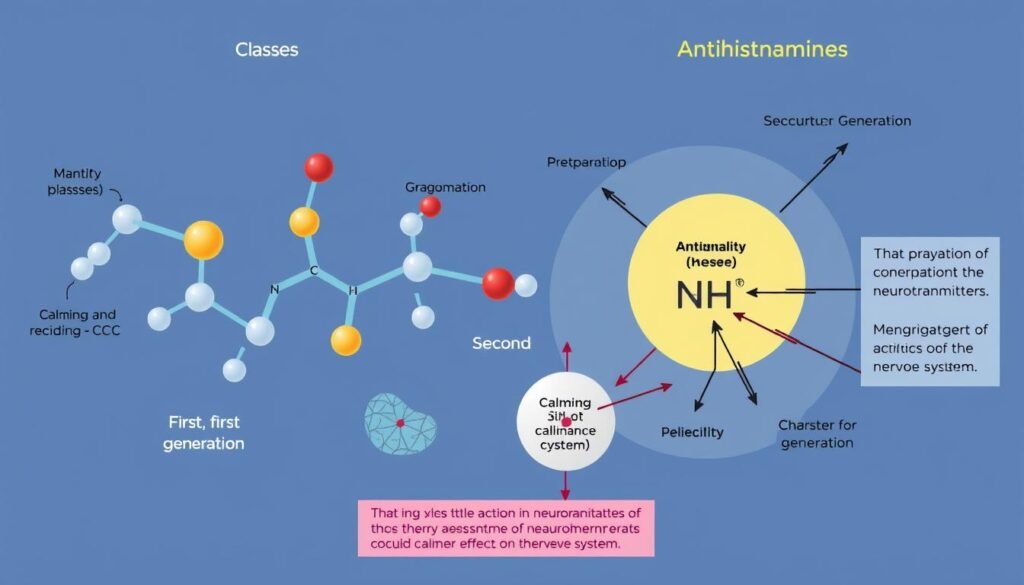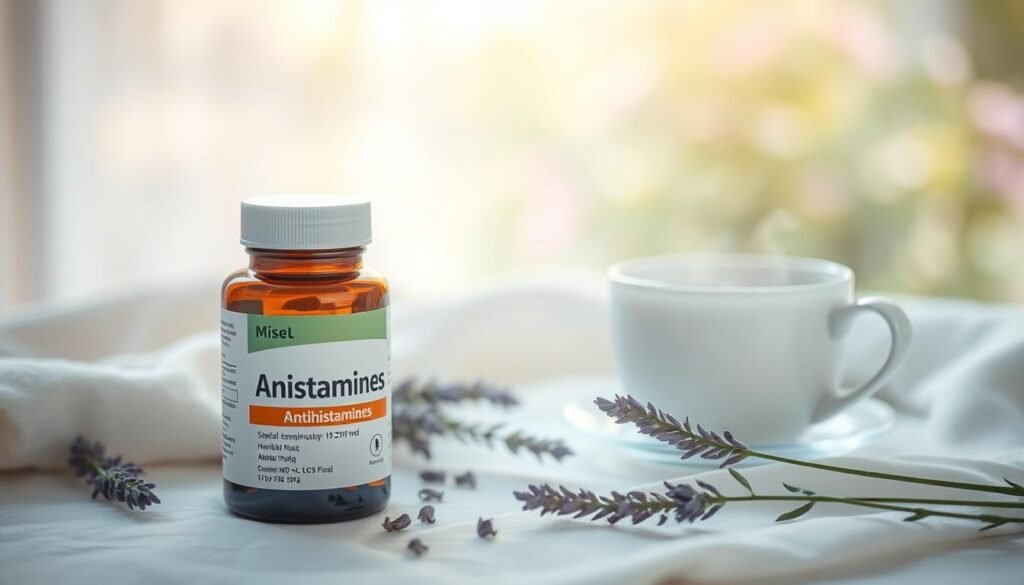About 19.1% of adults in the United States deal with anxiety disorders. This number shows a growing concern for mental health. In the search for effective treatments, antihistamines come into play. They are mostly known for treating allergies, but now they’re being seen as a possible help for anxiety too. Hydroxyzine, in particular, is getting noticed as a top choice for people looking for less dependency-risk options to benzodiazepines.
Looking into antihistamines for anxiety opens up new possibilities and challenges. These drugs may help in the short term, but it’s crucial to weigh their pros and cons. This discussion aims to highlight how natural antihistamines could ease symptoms and help bring back peace of mind.
Key Takeaways
- 19.1% of U.S. adults are diagnosed with anxiety disorders.
- Hydroxyzine is a common antihistamine used off-label for anxiety.
- Antihistamines generally pose a lower risk of addiction compared to benzodiazepines.
- Side effects from antihistamines can include drowsiness and gastrointestinal issues.
- Clinical studies are needed to further assess the effectiveness of antihistamines for anxiety.
- Antihistamines may provide short-term relief but do not address underlying anxiety causes.
Understanding Anxiety: An Overview
Understanding anxiety is key for those it affects. Anxiety disorders are conditions that affect many in the U.S. They show up in different ways, impacting lives every day.
The Nature of Anxiety Disorders
Anxiety disorders cover several types, like generalized anxiety disorder and panic disorder. About 18.1% of adults face these disorders yearly. This fact highlights a major mental health issue that needs attention and care. People of all backgrounds can experience anxiety, even from a young age. It can greatly affect one’s life in personal and school areas.
Common Symptoms and Types of Anxiety
The symptoms of anxiety include emotional and physical signs, which vary by disorder. Common symptoms are:
- Excessive worry about daily situations
- Restlessness or feeling on edge
- Physical symptoms like a racing heart, shortness of breath, or stomachaches
- Increased visits to medical professionals due to anxiety-related issues
Children might avoid certain situations to cope, affecting school and friendships. Emotional and physical symptoms show how complex anxiety disorders are. They highlight the importance of knowing about these conditions and finding the right treatments.
The Importance of Treating Anxiety
Treating anxiety is very important for one’s physical and mental well-being. Not dealing with anxiety can have bad outcomes. It can mess up someone’s everyday life.
Untreated anxiety may show up in many ways. This includes big troubles in social settings and daily activities. People might use bad ways to cope, like using drugs, to try and feel better.
Effects of Untreated Anxiety
Ignoring anxiety can make things worse. It can cause symptoms that make it hard to work or keep up relationships. If you don’t treat anxiety, you might face:
- Increased likelihood of substance abuse
- Higher rates of comorbid mental health issues
- Worsening physical health conditions
- Difficulty in maintaining employment
- Strained relationships with family and friends
Statistics on Anxiety in the United States
Knowing how common anxiety is shows why we need good treatment. About 19.1% of adults in the US have anxiety disorders each year. This big number shows why we must know about this and have good treatments available.
| Statistic | Percentage |
|---|---|
| Adults with Anxiety Disorders | 19.1% |
| Lifetime Prevalence of Anxiety Disorders | 32% |
| Global Prevalence of Anxiety Disorders | 15% increase since 2005 |
| Response Rate to Current Treatments | 60-85% |
By focusing on timely treatments, we can greatly better the lives of those dealing with anxiety. It leads to a healthier and happier life experience.

What Are Antihistamines?
Antihistamines are key in fighting allergic reactions and easing anxiety. They work by blocking histamine receptors in our body. This action helps tackle various issues. We’ll look into how antihistamines work and their types for a better grasp.
How Antihistamines Work
Antihistamines stop histamine from acting up during allergies. Histamine is a chemical that causes itching, swelling, and anxiety. By preventing histamine from binding to its receptors, antihistamines ease allergy symptoms and can also help with anxiety. This shows why antihistamines are significant beyond just treating allergies.
Different Classes of Antihistamines
There are two main groups of antihistamines, each with its own features and uses. We have:
- First-Generation Antihistamines: These can make you sleepy because they get into the brain. Examples are diphenhydramine (Benadryl) and hydroxyzine. They’re good for allergies and anxiety.
- Second-Generation Antihistamines: They’re less likely to make you sleepy. This group includes Loratadine (Claritin) and cetirizine (Zyrtec), which don’t cause sedation.
Knowing the differences helps in choosing the right antihistamines for your needs.
| Class of Antihistamines | Common Examples | Sedating? | Uses |
|---|---|---|---|
| First-Generation | Diphenhydramine (Benadryl), Hydroxyzine | Yes | Allergies, Anxiety, Insomnia |
| Second-Generation | Loratadine (Claritin), Cetirizine (Zyrtec) | No | Allergies |

Can I Use Antihistamine for Anxiety?
Using antihistamines for anxiety treatment is getting popular for non-standard uses. Though mainly for allergies, some medications may help with anxiety. For instance, hydroxyzine has FDA approval for treating anxiety.
Research shows off-label antihistamines like Benadryl may help in anxious times due to their calming effect. However, one must consult a doctor first due to potential risks.
Off-Label Use of Antihistamines
Some people use antihistamines like diphenhydramine for anxiety. About one-fourth to one-third of users feel more relaxed. If you’re thinking about it, talking to a health expert is key.
It’s not a good idea to only use antihistamines for anxiety. The risks and how well they work are not fully known.
Common Antihistamines Recommended for Anxiety
Hydroxyzine is often recommended for anxiety among other antihistamines. Here’s a look at some common ones used off-label for anxiety:
| Antihistamine | FDA Approval for Anxiety | Sedative Effects (%) | Common Dosage (Adult) |
|---|---|---|---|
| Hydroxyzine (Atarax, Vistaril) | Yes | Variable | 50 mg every 6 hours as needed |
| Diphenhydramine (Benadryl) | No | 25-30% | 25 or 50 mg every 4-6 hours |
| Doxylamine | No | Variable | 25 mg at bedtime |
Some might find help using antihistamines for anxiety. Yet, talking with a health expert about your options is very important.

Antihistamines and Anxiety Relief: How Do They Work?
Anxiety disorders are not simple; they often relate to neurotransmitter imbalances. Histamine affects our alertness and mood. If histamine levels are too high or too low, it may lead to anxiety. First-generation antihistamines have a calming effect. This suggests they might be useful in easing anxiety.
Histamine and Its Role in Anxiety
Histamine plays a part in the stress response of our bodies. It affects neurotransmitters like serotonin and GABA, which help control anxiety. If histamine is unbalanced, you might feel anxious or restless. This shows why managing histamine could help treat anxiety.
Mechanism of Antihistamines in the Central Nervous System
Antihistamines block histamine receptors in the brain, aiding in anxiety relief. Especially, first-generation antihistamines like diphenhydramine can calm you and lessen anxiety. However, they have side effects such as drowsiness. It’s crucial to weigh these against the advantages when considering antihistamines for anxiety.
Potential Side Effects of Antihistamines
Antihistamines help relieve allergies and anxiety, but they have side effects. Common ones are drowsiness, dry mouth, and dizziness. Serious health issues can happen with misuse or long-term use. It’s important to use them safely.
Common Side Effects
- Drowsiness
- Dry mouth
- Dizziness
- Headaches
- Nausea
- Abdominal pain
First-generation H1 antihistamines can also slow down your coordination and judgment. They can make you feel sleepy or less alert. This means you have to be careful when driving or using machines.
Serious Risks and Considerations
Using first-generation H1 antihistamines might lead to an overdose risk, especially in kids and older people. If someone shows symptoms like extreme sleepiness or agitation, they need urgent medical care.
Additionally, certain conditions can get worse with antihistamines. These conditions are:
- Diabetes
- Enlarged prostate
- Heart disease
- Glaucoma
Long-term use might lead to dependence on drugs like diphenhydramine. There’s research showing a link between these drugs and a higher chance of dementia in the elderly. It’s very important to talk to your doctor about how much and how long you should use these medicines.
| Side Effect | Likelihood | Severity |
|---|---|---|
| Drowsiness | Common | Moderate |
| Dry Mouth | Common | Low |
| Headaches | Common | Low |
| Dizziness | Common | Moderate |
| Agitation | Less Common | High |
| Overdose Symptoms | Rare | Very High |
Antihistamines vs. Traditional Anxiety Medications
Choosing between antihistamines and standard anxiety meds is a big decision. It involves looking at how well they work and their risk of addiction. These medicines help with anxiety in different ways and have various long-term effects.
Effectiveness Comparison
Comparing antihistamines vs traditional anxiety medications, there’s a big difference in effectiveness. Benzodiazepines work fast but might not work as well after 4 to 6 months. This could make people take more to get relief. SSRIs could take up to six weeks to start working, and some research says they might not work better than a placebo.
Antihistamines, like hydroxyzine, start working in just a few hours. But, you shouldn’t use them for more than four months. On the other hand, benzodiazepines might need to be used longer. Side effects of standard meds include:
- Drowsiness
- Dizziness
- Poor concentration
- Memory problems
- Fatigue
Dependency and Withdrawal Risks
The risk of getting hooked on anxiety medication is an essential issue. Benzodiazepines can lead to addiction quickly, even in just a few weeks. Stopping them might cause extreme anxiety and flu-like symptoms. SSRIs also have withdrawal issues like irritability and insomnia, but the risk is smaller than with benzodiazepines.
Hydroxyzine, an antihistamine, has a lower addiction risk. It’s a good option for older people or those who’ve struggled with addiction before. But, using any anxiety medication should be done carefully to avoid problems.
| Medication Type | Time to Relief | Dependency Risk | Common Side Effects |
|---|---|---|---|
| Benzodiazepines | Immediate | High | Drowsiness, dizziness, poor coordination |
| SSRIs | 4-6 weeks | Moderate | Nausea, fatigue, sexual dysfunction |
| Hydroxyzine | Hours | Low | Fatigue, dizziness, drowsiness |
| Benadryl | Hours | Low | Drowsiness, dry mouth, blurred vision |
Alternatives to Antihistamines for Anxiety Treatment
Finding the right way to handle anxiety might mean trying out various options. Non-drug treatments can offer good ways to deal with anxiety, alongside medicine like antihistamines. Cognitive Behavioral Therapy (CBT) stands out as a big help. Natural remedies and changes in your way of living are also key for a full approach.
Cognitive Behavioral Therapy (CBT)
CBT is a focused therapy that targets harmful thoughts that cause anxiety. It teaches people to replace bad thoughts with positive, realistic ones. This change helps manage anxiety better. Studies back CBT’s success, recommending it as a primary choice for different anxiety types.
Other Natural Remedies and Lifestyle Changes
Along with CBT, there are many natural methods for easing anxiety, such as:
- Aerobic Exercise: Intense workouts can greatly reduce anxiety levels and improve mental health.
- Mindfulness and Meditation: Being mindful brings a person’s focus to the present, reducing worry.
- Journaling: Writing down thoughts and feelings helps sort through emotions, clearing the mind.
- Grounding Techniques: The 3-3-3 rule, focusing on surroundings, helps distract from anxiety.
- Music Therapy: Calming music can lessen stress and help relaxation.
These methods offer great alternatives to antihistamines. They help people manage anxiety in an effective way. Below is a comparison of these treatments:
| Treatment Method | Type | Effectiveness | Notes |
|---|---|---|---|
| Cognitive Behavioral Therapy (CBT) | Therapeutic | High | Evidence-based method for anxiety disorders. |
| Aerobic Exercise | Physical Activity | Moderate to High | Shown to lower anxiety significantly. |
| Mindfulness and Meditation | Natural | Moderate | Helps maintain present-focus, reducing anxiety. |
| Medication (SSRIs, SNRIs) | Pharmacological | High | Preferred first-line treatment for anxiety. |
| Natural Remedies (e.g., herbal supplements) | Natural | Variable | Consult healthcare providers before use. |
Conclusion
Antihistamines can offer *short-term anxiety relief options*, but they shouldn’t be the only treatment. People with anxiety disorders like Generalized Anxiety Disorder and Panic Disorder should also try Cognitive Behavioral Therapy and SSRIs. These treatments tackle both symptoms and root issues, leading to better anxiety management.
Some antihistamines, such as hydroxyzine, are effective but carry side effects and risks, particularly for those with existing health issues. Consulting a mental health professional before using antihistamines for anxiety is key. They can help design a plan that fits individual needs.
Early action and a full care approach are important for managing anxiety successfully. By understanding that antihistamines are only a temporary fix, individuals can focus on holistic methods. This approach can significantly improve quality of life.